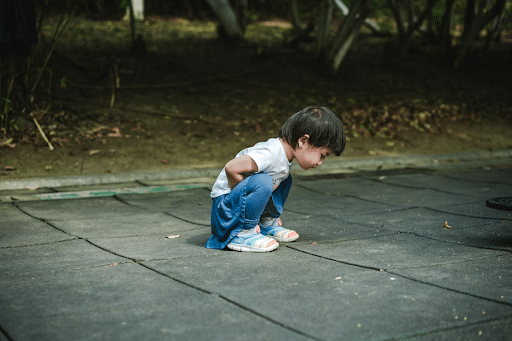If you’ve landed here, chances are you’re already a pediatric therapist who knows that pelvic floor dysfunction exists in kids. You’ve seen it firsthand—bedwetting beyond the age of 5, kids with chronic constipation, constant leaking, or even behavioral outbursts during potty training that don’t quite fit the mold. But what can you do about it?
Pediatric pelvic floor therapy is still considered a specialty, but here’s the truth: you don’t need to be a specialist to start making a difference. Most pediatric PTs and OTs are already seeing kids whose symptoms are pelvic floor-related. They just need the right lens and tools to identify and address pelvic floor dysfunction.
So, how do you know if it’s time to start learning about the pediatric pelvic floor? Here are three clear signs that you’re ready.

1. You’re Treating Bowel And Bladder Problems In Children Without Lasting Results
Let’s talk about the “frequent flyers.”
If you’ve been practicing in a pediatric therapy setting for any amount of time, you’ve probably had a handful of kids who return again and again with the same issues:
- Constipation that persists despite dietary changes
- Daytime wetting that’s been blamed on attention issues
- Nighttime bedwetting long past the expected age
- Urgency or frequency without a clear medical reason
- Kids who “just don’t seem to feel” when they need to go
You’ve ruled out behavioral causes. You’ve tried sticker charts, alarms, rewards, and even consulted with physicians. Maybe the family has seen a gastroenterologist or urologist. But the child is still struggling, and so are you.
Here’s the missing piece: the pelvic floor plays a foundational role in all of these functions. When these muscles are tight, weak, or uncoordinated, kids may experience overflow incontinence from chronic stool withholding or develop dysfunctional voiding habits that lead to incomplete emptying. They may also have decreased sensory awareness or become overly sensitive in the pelvic region, or fall into holding patterns that perpetuate the cycle.
But pediatric pelvic floor therapy isn’t just about muscle tone and coordination. You must incorporate a comprehensive perspective into your practice to address:
- Lifestyle factors such as hydration, nutrition, toileting schedules, and physical activity
- Habit patterns like postures, holding strategies, and bathroom avoidance
- Interoception—the child’s ability to sense and interpret internal body cues
- Anatomy and physiology education to help kids and parents understand what’s happening
- Evidence-based testing and evaluation so interventions are targeted, not guesswork
When you know how to assess all of these elements and apply appropriate, strategic interventions, you stop chasing symptoms and start addressing the root causes. This is where you provide kids with lasting changes.
Learning how to evaluate and address bowel and bladder dysfunction opens up a whole new set of tools to finally move these kids forward and help families feel more supported.

2. You’re Missing the Pelvic Floor In Your Pediatric Core And Motor Work
As a pediatric therapist, your toolbox is probably full of strategies for core and postural strengthening, progressing gross motor milestones, and supporting sensory processing. These skills are essential for building a strong foundation in kids. But even with all these tools, you may still encounter children who continue to struggle with bowel and bladder dysfunction despite progress in other areas.
Often, that’s because one key system is being overlooked: the pelvic floor. As part of the core, the pelvic floor works in harmony with the diaphragm and abdominals to control not only movement, but also bladder and bowel function. When you leave the pelvic floor out of the equation, progress can plateau, leaving the therapist and family feeling stuck.
If you’re doing all the work “above and around” the pelvic floor without knowing how to assess or engage it, you’re not addressing the full picture. Understanding how to integrate pelvic floor function into your existing treatment plans can bridge that gap and help children make meaningful, lasting gains.
You don’t have to abandon the work you’re already doing. Adding pediatric pelvic floor therapy strategies enhances your existing interventions. You’ll be able to integrate toileting-related goals seamlessly into your sensory, motor, and postural plans, rather than treating them as a separate problem or referring out unnecessarily.

3. You’re Referring Out Pelvic Floor Cases, And Families Aren’t Getting Help
Referring out often feels like the right thing to do, but it can leave families in limbo.
If you’ve ever told a parent:
- “I think this might be pelvic floor-related. Ask your doctor for a referral.” or
- “You might want to try a pelvic floor specialist, but I’m not trained in that.”
…then watched as nothing came of it, you know the frustration.
Most families dealing with a child who has bowel and bladder dysfunction are already overwhelmed. They may not follow through on a referral due to cost, access, waitlists, or confusion about what pelvic floor therapy even is. In the meantime, the child continues to struggle, and the trust the family has built with you begins to feel like a dead end.
When you’re trained in basic pediatric pelvic floor evaluation and treatment, you don’t have to send them away. You can:
- Screen for red flags or dysfunction during your regular evaluation
- Offer education and resources immediately
- Start basic interventions that build awareness and coordination
- Know when a referral is necessary—and how to advocate effectively for it
This builds confidence in your clinical decision making and continuity for families who desperately want help but don’t know where to turn.

Ready to Get Started?!
If you’ve been hesitant to dive into pediatric pelvic floor therapy because you’re not a “specialist,” consider this need:
- You don’t need an internal certification
- You don’t need fancy equipment
- You don’t need to treat pelvic floor issues full-time
What you do need is the willingness to learn and the tools to start addressing pelvic floor function through practical, evidence-based strategies that fit into your current sessions.
That’s exactly what we cover in Pediatrics Level 1 – Treatment of Bowel and Bladder Disorders: Evaluation and Treatment of Dysfunctional Voiding, Bedwetting, and Constipation.
Peds Level 1 was built for pediatric PTs and OTs who are hearing about the symptoms, but haven’t been taught what to do about them.
If this blog post has you nodding along, you’re ready. You’ve already seen the signs, and now it’s time to gain the tools. You’ll finish feeling confident and more equipped to help the kids you already care for.
Whether you want to better serve the kids who are already on your caseload, reduce frustration for families, or finally connect the dots with kids’ toileting issues, this training was made for you!
Join us for the next live Peds Level 1 – Treatment of Bowel and Bladder Disorders on August 23-24, 2025.
